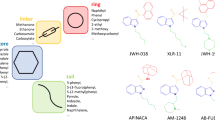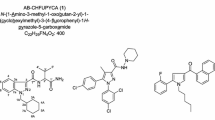Abstract
Four herbal incense products were seized from suspected drug abusers in Korea. The major ingredients in the herbal incense samples were purified, and their structures were elucidated using gas chromatography–electron ionization–mass spectrometry (GC–EI–MS), liquid chromatography–time-of-flight–mass spectrometry (LC–TOF–MS), and 1D and 2D nuclear magnetic resonance (NMR) spectroscopy. As a result, ingredients in the herbal incense were identified as (1-pentylindol-3-yl)-(2,2,3,3-tetramethylcyclopropyl)methanone and its 5-pentyl fluorinated analog [1-(5-fluoropentyl)indol-3-yl]-(2,2,3,3-tetramethylcyclopropyl)methanone. The former is being sold via the Internet as a "research chemical" named UR-144, and the latter is sold as 5F-UR-144. UR-144 is a selective full agonist of CB2 cannabinoid receptor, and was first developed by Abbott Laboratories as an analgesic. It exhibits analgesic activity against both neuropathic and inflammatory pain associated mainly with the CB2 receptor, but shows less psychotropic effects associated with the CB1 receptor. Fluorination of the N-pentyl side chain of cannabimimetic compounds increases their cannabinoid receptor affinity such as with AM-2201, which shows both increased analgesic and psychotropic effects simultaneously. UR-144 and 5F-UR-144 can be classified as research chemicals based on their analgesic effects, but in practice are abused as psychotropic agents and can cause unexpected toxic effects. Thus, the trade and diversion of these chemicals should be monitored carefully for possible abuse. To our knowledge, this is the first report disclosing cyclopropylcarbonylindoles in herbal products.





Similar content being viewed by others
References
Aung MM, Griffin G, Huffman JW, Wu MJ, Keel C, Yang B, Showalter VM, Abood ME (2000) Influence of the N-1 alkyl chain length of cannabimimetic indoles upon CB1 and CB2 receptor binding. Drug Alcohol Depend 60:133–140
Huffman JW, Szklennik PV, Almond A, Bushell K, Selley DE, He H, Cassidy MP, Wiley JL, Martin BR (2005) 1-Pentyl-3-phenylacetylindoles, a new class of cannabimimetic indoles. Bioorg Med Chem Lett 15:4110–4113
Uchiyama N, Kawamura M, Kikura-Hanajiri R, Goda Y (2009) Identification of a cannabimimetic indole as a designer drug in a herbal product. Forensic Toxicol 27:61–66
Auwärter V, Dresen S, Weinmann W, Müller M, Pütz M, Fereirós N (2009) ‘Spice’ and other herbal blends: harmless incense or cannabinoid designer drugs? J Mass Spectrom 44:832–837
Lindigkeit R, Boehme A, Eiserloh I, Luebbecke M, Wiggermann M (2009) Spice: a never ending story? Forensic Sci Int 191:58–63
Nakajima J, Takahashi M, Seto T, Kanai C, Suzuki J, Yoshida M, Hamano T (2011) Identification and quantitation of two benzoylindoles AM-694 and (4-methoxyphenyl)(1-pentyl-1H-indol-3-yl)methanone, and three cannabimimetic naphthoylindoles JWH-210, JWH-122, and JWH-019 as adulterants in illegal products obtained via the Internet. Forensic Toxicol 29:95–110
Nakajima J, Takahashi M, Seto T, Suzuki J (2011) Identification and quantitation of cannabimimetic compound JWH-250 as an adulterant in products obtained via the Internet. Forensic Toxicol 29:51–55
Uchiyama N, Kawamura M, Kikura-Hanajiri R, Goda Y (2011) Identification and quantitation of two canabimimetic phenylacetylindoles JWH-251 and JWH-250, and four cannabimimetic naphthoylindoles JWH-081, JWH-015, JWH-200, and JWH-073 as designer drugs in illegal products. Forensic Toxicol 29:25–37
Nakajima J, Takahashi M, Nonaka R, Seto T, Suzuki J, Yoshida M, Kanai C, Hamano T (2011) Identification and quantitation of a benzoylindole (2-methoxyphenyl)(1-pentyl-1H-indole-3-yl)methanone and a naphthoylindole 1-(5-fluoropentyl-1H-indol-3-yl)(naphthalene-1-yl)methanone (AM-2201) found in illegal products obtained via the Internet and their cannabimimetic effects evaluated by in vitro [35S]GTPγS binding assays. Forensic Toxicol 29:132–141
Ernst L, Schiebel HM, Theuring C, Lindigkeit R, Beuerle T (2011) Identification and characterization of JWH-122 used as new ingredient in “Spice-like” herbal incenses. Forensic Sci Int 208:e31–e35
Moosmann B, Kneisel S, Girreser U, Brecht V, Westphal F, Auwärter V (2012) Separation and structural characterization of the synthetic cannabinoids JWH-412 and 1-[(5-fluoropentyl)-1H-indol-3yl]-(4-methylnaphthalen-1-yl)methanone using GC-MS, NMR analysis and a flash chromatography system. Forensic Sci Int 220:e17–e22
Jankovics P, Váradi A, Tölgyesi L, Lohner S, Németh-Paloás J, Balla J (2012) Detection and identification of the new potential synthetic cannabinoids 1-pentyl-3-(2-indobenzoyl)indole and 1-pentyl-3-(1-adamantoyl)indole in seized bulk powders in Hungary. Forensic Sci Int 214:27–32
Nakajima J, Takahashi M, Seto T, Yoshida M, Kanai C, Suzuki J, Hamano T (2012) Identification and quantitation of two new naphthoylindole drugs-of-abuse, (1-(5-hydroxypentyl)-1H-indol-3-yl)(naphthalen-1-yl)methanone (AM-2202) and (1-(4-pentenyl)-1H-indol-3-yl)(naphthalen-1-yl)methanone, with other synthetic cannabinoids in unregulated “herbal” products circulated in the Tokyo area. Forensic Toxicol 30:33–44
Uchiyama N, Kawamura M, Kikura-Hanajiri R, Goda Y (2012) Identification of two new-type synthetic cannabinoids, N-(1-adamantyl)-1-pentyl-1H-indole-3-carboxamide (APICA) and N-(1-adamantyl)-1-pentyl-1H-indazole-3-carboxamide (APINACA), and detection of five synthetic cannabinoids, AM-1220, AM-2233, AM-1241, CB-13 (CRA-13), and AM-1248, as designer drugs in illegal products. Forensic Toxicol 30:114–125
Kneisel S, Bisel P, Brecht V, Broecker S, Müller M, Auwärter V (2012) Identification of the cannabimimetic AM-1220 and its azepane isomer (N-methylazepan-3-yl)-3-(1-naphthoyl)indole in a research chemical and several herbal mixtures. Forensic Toxicol 30:126–134
UNODC (2011) World drug report 2011. United Nations Office of Drugs and Crime, Vienna
Munro S, Thomas KL, Abu-Shaar M (1993) Molecular characterization of a peripheral receptor for cannabinoids. Nature 365:61–65
EMCDDA (2009) Thematic papers: understanding the “Spice” phenomenon. European Monitoring Centre for Drugs and Drug Addiction, Lisbon
Zimmermann US, Winkelmann PR, Pilhatsch M, Nees JA, Spanagel R, Schulz K (2009) Withdrawal phenomena and dependence syndrome after the consumption of “spice gold”. Dtsch Arztebl Int 106:464–467
Schneir AB, Baumbacher T (2012) Convulsions associated with the use of a synthetic cannabinoid product. J Med Toxicol 8:62–64
Lapoint J, James LP, Moran CL, Nelson LS, Hoffman RS, Moran JH (2011) Severe toxicity following synthetic cannabinoid ingestion. Clin Toxicol 49:760–764
Malan TP Jr, Ibrahim MM, Lai J, Vanderah TW, Makriyannis A, Porreca F (2003) CB2 cannabinoid receptor agonists: pain relief without psychoactive effects? Curr Opin Pharmacol 3:62–67
Clayton N, Marshall FH, Bountra C, O’Shaughnessy CT (2002) CB1 and CB2 cannabinoid receptors are implicated in inflammatory pain. Pain 96:253–260
Quartiho A, Mata HP, Ibrahim MM, Vanderah TW, Porreca F, Makriyannis A, Malan TP Jr (2003) Inhibition of inflammatory hyperalgesia by activation of peripheral CB2 cannabinoid receptors. Anesthesiology 99:955–960
Pace JM, Tietje K, Dart MJ, Meyer MD (2006) 3-Cycloalkylcarbonyl indoles as cannabinoid receptor ligands. Published in 2006-06-29, assigned to Abbott Laboratories
Frost JM, Dart MJ, Tietje KR, Garrison TR, Grayson GK, Daza AV, El-Kouhen OF, Yao BB, Hsieh GC, Pai M, Zhu CZ, Chandran P, Meyer MD (2010) Indol-3-ylcycloalkyl ketones: effects of N1 substituted indole side chain variations on CB(2) cannabinoid receptor activity. J Med Chem 53:295–315
Mauler F, Mittendorf J, Horváth E, De Vry J (2002) Characterization of the diarylether sulfonylester (-)-(R)-3-(2-hydroxymethylindanyl-4-oxy)phenyl-4,4,4-trifluoro-1-sulfonate (BAY 38–7271) as a potent cannabinoid receptor agonist with neuroprotective properties. J Pharmacol Exp Ther 302:359–368
Acknowledgments
This study was supported by funding from the National R & D Program of the Ministry of Education, Science, and Technology (2012-0009836) and the National Forensic Service of Korea.
Author information
Authors and Affiliations
Corresponding author
Rights and permissions
About this article
Cite this article
Choi, H., Heo, S., Kim, E. et al. Identification of (1-pentylindol-3-yl)-(2,2,3,3-tetramethylcyclopropyl)methanone and its 5-pentyl fluorinated analog in herbal incense seized for drug trafficking. Forensic Toxicol 31, 86–92 (2013). https://doi.org/10.1007/s11419-012-0170-5
Received:
Accepted:
Published:
Issue Date:
DOI: https://doi.org/10.1007/s11419-012-0170-5




